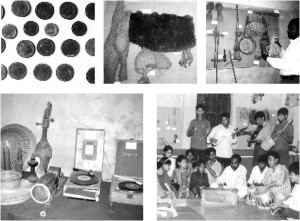| Behind the Scene
From Bogra
Majid's Museum
Selina Sheuly
 People have lots of different types of hobbies. Some collect stamps. Some collect coins. Some collect antiques. Out of all these collectors, there are some who turn their collections into exhibits- like mini-museums. They have done it through their own desire. One such collector is Abdul Majid. People have lots of different types of hobbies. Some collect stamps. Some collect coins. Some collect antiques. Out of all these collectors, there are some who turn their collections into exhibits- like mini-museums. They have done it through their own desire. One such collector is Abdul Majid.
Abdul Majid is a teacher by profession. He teaches little children. Outside of his teaching, he organises things. He looks for the roots of his culture. He has built up a collection of handicrafts and folk artifacts using rare and antiquated things. There is a very old set of weighing scales, but without the weights. There is a harmonium and a gramophone. There are wooden shoes. Other objects in the collection include “Haridasher puthi”. No one expects such an interesting exhibit in this little village in the middle of nowhere.
Punat village is pretty close to Kalai. You can go there by bus, or take a rickshaw from Kalai. You notice the little museum as soon as you enter the village. It is a small poorly lit room. Abdul Majid is a lover of music. In 1995 he took the initiative of forming the 'Lok Samskriti Parishad'. Then he established this museum in Bogra and Joypurhat. At one time, Majid worked for Grameen Bank. He worked at the grassroots level. He has met many different types of people. He has seen their culture, their music. In Thakurgaon he has witnessed their regional songs, their rhymes, their poetry. The people he met helped Majid build up his collection. People like Shafiqul Islam, Shafiul Bari Russell, Hasan Ali, Mohanta Barman and others helped him. All these people are quite young.
Majid, along with his organisation, found books and periodicals from 80 years ago. Mostly writers from Joypurhat- their books, magazines and paper cuttings. There are volumes printed in the Bengali year 1334. the monthly magazine Mohammadi, published in 1350 Bengali is there too. There are rare pictures here too. There are works by women, mostly done under masculine pseudonyms, since it was so hard for women to get their work published.
Abdul Majid doesn't just collect stuff, he is also a musician. He plays both the sitar and the violin. He got together some interested people and started teaching music to kids of the area.
The government doesn't really assist Majid's museum. This is something that basically grew out of individual initiative and volunteer work. However, with the right kind of patronage; this place can become a centre for research and education. In two rented rooms there are over 300 objects of interest. There are things from 100 years ago. Not everything here is made by humans; Majid has collected some bird's nests too. There is a palanquin and plenty of coins that were used a long time ago. This place has the potential to be a treasure house of culture and a great place of learning. With a little more funding, it could really make a name for itself.
Copyright
(R) thedailystar.net 2008 |
